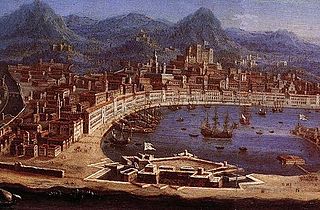
Syracuse is a historic city on the Italian island of Sicily, the capital of the Italian province of Syracuse. The city is notable for its rich Greek and Roman history, culture, amphitheatres, architecture, and as the birthplace and home of the pre-eminent mathematician and engineer Archimedes. This 2,700-year-old city played a key role in ancient times, when it was one of the major powers of the Mediterranean world. Syracuse is located in the southeast corner of the island of Sicily, next to the Gulf of Syracuse beside the Ionian Sea. It is situated in a drastic rise of land with 2,000 metres (6,600 ft) depths being close to the city offshore although the city itself is generally not so hilly in comparison.

Marsala is an Italian comune located in the Province of Trapani in the westernmost part of Sicily. Marsala is the most populated town in its province and the fifth largest in Sicily.

City Gate is a gate located at the entrance of Valletta, Malta. The present gate, which is the fifth one to have stood on the site, was built between 2011 and 2014 to designs of the Italian architect Renzo Piano.

The Sforza Castle is a medieval fortification located in Milan, northern Italy. It was built in the 15th century by Francesco Sforza, Duke of Milan, on the remnants of a 14th-century fortification. Later renovated and enlarged, in the 16th and 17th centuries it was one of the largest citadels in Europe. Extensively rebuilt by Luca Beltrami in 1891–1905, it now houses several of the city's museums and art collections.

Prince of Ligne is a title of Belgian nobility that belongs to the House of Ligne, which goes back to the eleventh century. It owes its name to the village in which it originated, between Ath and Tournai. The lords of Ligne belonged to the entourage of the Count of Hainaut at the time of the Crusades.

Claude Lamoral, 3rd Prince of Ligne, Prince of Epinoy, Marquis of Roubaix and Count of Fauquemberg, was a nobleman from the Spanish Netherlands, a soldier and diplomat in the service of Philip IV of Spain and Charles II of Spain.

The walls of Genoa constitute in their whole the several circles of walls that protected and defended the city of Genoa, former capital of the homonymous republic. To this day, large portions of these walls remain, and Genoa has more and longer walls than any other city in Italy.

The Walls of Nicosia, also known as the Venetian Walls, are a series of defensive walls which surround Nicosia, the capital city of Cyprus. The first city walls were built in the Middle Ages, but they were completely rebuilt in the mid-16th century by the Republic of Venice. The walls are still largely intact, and are among the best preserved Renaissance fortifications in the Eastern Mediterranean. They are a major tourist attraction.

The fortifications of Mdina are a series of defensive walls which surround Mdina, the former capital city of Malta from antiquity to the medieval period. The city was founded as Maleth by the Phoenicians in around the 8th century BC, and it later became part of the Roman Empire under the name Melite. The ancient city was surrounded by walls, but very few remains of these have survived.

Carlos de Grunenbergh, also known as Carlo Grunenberg, was a Flemish architect and military engineer active in the late 17th century. He mainly designed fortifications in Sicily and Malta. He was also a member of the Order of Saint John.

Ligny Tower is a coastal watchtower in Trapani, Sicily. It was built between 1671 and 1672 at a strategic position on the city's western coast. Today, the tower is in good condition, and it is open to the public as an archaeological museum.

The Real Cittadella was a fort in Messina, Sicily. The Cittadella was built between 1680 and 1686 by the Spanish Empire, and it was considered to be one of the most important fortifications in the Mediterranean. Most of the fort was demolished in the 20th century, but some parts can still be seen.

Forte Gonzaga, also known as Castel Gonzaga, is a bastioned fort in Messina, Sicily. It was built in the mid-16th century, and it remained in use by the military until 1973. Today, the fort is in good condition.

The fortifications of Messina were a series of defensive walls and other fortifications which surrounded the city of Messina, Sicily. The first walls were built during the Middle Ages in around 1200. A system of bastioned fortifications was constructed around the city in the 1530s and 1540s. The fortifications were modified over the years, with the last major addition being the Real Cittadella, which was built in the 1680s. Most of the walls were demolished in the 19th and 20th centuries, but some parts of the walls still survive today.

Victoria Gate is a city gate in Valletta, Malta. It was built by the British in 1885, and was named after Queen Victoria. The gate is the main entrance into the city from the Grand Harbour area, which was once the busiest part of the city. The gate is located between Marina Curtain and St. Barbara Bastion, on the site of the 16th-century Del Monte Gate.
The following is a timeline of the history of the city of Syracuse, Sicily, Italy. Syracuse was the main city of Sicily from 5th century BCE to 878 CE.

The Walls of Grosseto, known also as Medicean Walls, are a series of defensive brick walls surrounding the city of Grosseto in Tuscany, Italy.

Porta Spagnola, also known as the Porta di Terra is a city gate in Augusta, Sicily. It was built between 1681 and 1682 as part of the city's fortifications.

Porta Montanara, historically known as Porta Sant'Andrea, is an ancient Roman city gate in the city of Rimini, in the region of Emilia-Romagna, northern Italy.




















